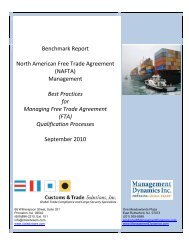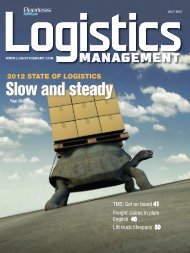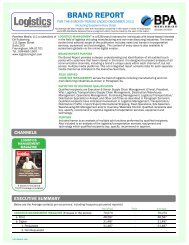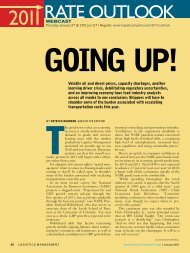A special supplement to logistics managementAccording to Jim Edgar, regionaldirector of cargo marketing for Boeing,China represents 40 percent of thetrans-Pacific cargo market, and HongKong is a key gateway for air cargo connectingChina with the world.“This area stands to benefit greatlyfrom future increases in air cargo traffic,”says Edgar. “Of local interest and inline with the cargo recovery, Hong KongAir Cargo Terminals Limited announcedthat total annual tonnage for 2010 hita new handling record of 2.9 millionmetric tons, an increase of 24.8 percentover 2009.”Tinseth says that rising cargo traffic iscreating pressure for fleet growth. Boeingresearchers say that airlines will need30,900 new passenger and freighterairplanes through 2030, valued at U.S.$3.6 trillion. Forty-four percent of theseaircraft will replace older, less efficientairplanes, while 56 percent will accountfor new aircraft needed to meet air trafficgrowth. The world fleet is projectedto expand twofold from 18,890 to36,300 airplanes during this span.“The near doubling of the world fleetsize is an indicator that airlines will notonly plan for growth, but will take theeconomically rational step of modernizingtheir fleets as a hedge againsthigh and unpredictable oil prices,” saysTinseth. “The global economic recoveryis helping airlines rebuild their balancesheets, leading toward a demand fornewer, fuel efficient, and environmentallyprogressive airplanes worldwide.”Growth in developing and emergingmarkets, and the need to replace agingfleets, are but two main reasons drivingthis trend, say Boeing analysts—anobservation being echoed by the top aircargo providers.At the same time, however, some analystsare sounding a cautionary note onthis strategy. Charles Clowdis, Jr., managingdirector of transportation advisoryservices for IHS Global Insight, says shippersmay opt for slower ocean carriage inthe trans-Pacific if the economic reboundScheduled freight tons per mileInternational6 Singapore Airlines 7,001 6 Hainan Airlines 421Graphic caption7 China Airlines 6,410 7 All Nippon Airways 417is not robust.“Even some high-end consumergoods are moving on water now,” saysClowdis. “If this trend continues, aircargo providers may have a hard timegetting this volume back.”“Flat world” strategyNevertheless, air cargo leaders maintainthat there’s no reversing a “flat world”business strategy.“We all benefit from a world that’smore connected than ever,” says FredSmith, chairman, president, and CEOof FedEx. “In fact, the largest economyin the world no longer belongs to asingle country but to the realm of globaltrade. It’s driven by emerging markets,such as China and India, and worldwidegains in manufacturing.”Smith says that global trade willcontinue to be the prime source ofgrowth for FedEx, especially in Asia,where they have the strongest transportationnetwork in the industry. But he’salso concerned that his company may beapproaching a tipping point, noting thathe expects higher margin revenue frominternational operations to approach—ifDomesticRank Airline Millions Rank Airline Millions1 Cathay Pacific Airways 9,587 1 FedEx 8,3222 Korean Air 9,487 2 UPS Airlines 4,9793 Emirates 7,913 3 China Southern Airlines 1,2954 Lufthansa 7,422 4 Air China 9045 FedEx 7,421 5 China Eastern Airlines 7138 UPS Airlines 5,215 8 United Airlines 4139 EVA Air 5,166 9 Japan Airlines 40510 Cargolux 4,901 10 Delta Airlines 363Source: World Air transport statistics (WATS)not eclipse—U.S. domestic revenues atFedEx Express for the first time in itshistory.“Our commitment to providecompanies of all sizes with access to newmarkets in every corner of the worldhas never been stronger,” adds Smith.“FedEx not only sits at the nexus ofglobal trade—we are indispensible toglobal trade.”But does this beg the question: Whoisn’t? Certainly, UPS must comprise anotherpiece of that pantheon. For ScottDavis, chairman and CEO of UPS,that means a more balanced air cargorelationship.“When it comes to trade, we’reletting other countries move to the forefront,”Davis cautions. “What is neededis much stronger economic growthfueled by U.S. exports.”Davis, who is also a member of thePresident’s Export Council, acknowledgeschallenges facing the U.S., includingunsustainable federal deficits and thepersistently weak job market. But hecounters this by advocating a series ofsolutions, including:• Streamlining export controls. This<strong>Logistics</strong> <strong>Management</strong> • <strong>October</strong> <strong>2011</strong> 49S
Special Report: Leading Air Cargo CarriersA SPECIAL SUPPLEMENT TO LOGISTICS MANAGEMENTwould boost U.S. GDP by $64 billionand create about 160,000 manufacturingjobs over the next eight years.“That’s low hanging fruit,” says Davis.• Passing job-creating free trade agreementswith South Korea, Colombia, andPanama, which he said were “stuck in themud of partisanship” in Washington.“We have the means to competewith any country in the world and win,”Davis says. “Let’s clear away the barriersto exports and let global commerce shiftinto high gear and create much neededjobs here at home.”Airlines remain optimisticThis bullish attitude seems to be sharedby the airlines themselves. “Forwardbookings are not showing signs of weakening,and they remain strong…as doesoverall pricing,” says Dahlman Roseinvestment bank analyst Helane Becker.At the same time, however, they’remanaging the sluggish economy with capacitycuts and less competition becauseof airline consolidation. The most recentwas Southwest Airlines acquisition ofAirTran Airways.In the U.S., the industry has gonefrom 12 major carriers to seven, includingthe combinations of United andContinental Airlines and Delta Air Linesand Northwest Airlines. But shippers saythat this is no cause for alarm. “There’splenty of capacity for existing demand,”says Becker.Brandon Fried, executive director ofthe Air Forwarders Association, says hisconstituents are reporting that oceancarriers are relieving the pressure for thetime being. “This trend, though, is goingto be reversed soon,” he says. “This isa cyclical business, and we see high-techand the fashion industry as drivers forfuture demand.”Fried also pointed to American Airlinesas taking the lead in anticipating emergingmarkets for high-end perishables infood and pharma. “Maintaining coldchain integrity is going to be key in therecovery,” says Fried. The manufacturers ofSafety benefits and increased efficiency throughgreater choice of route selectionThe International Air Transport Association(IATA) announced the successfulcompletion of the first iFlex trial betweenJohannesburg and Atlanta. The iFlexconcept provides for a greater and moreflexible choice of routes on long-hauloperations which cross multiple flight informationregions to deliver shorter flighttimes, improved fuel efficiency, andreduced CO2 emissions while maintainingsafety.With iFlex, airlines will be able tofly more optimum routings that takemaximum advantage of wind conditions.While airlines have long planned flightsconsidering wind conditions, air trafficmanagement restrictions often limitedflexibility within fixed corridors on partsof routings. The innovation that iFlexbrings is the flexibility to extend thispractice consistently across the entirejourney.Delta Air Lines reported that theimplementation of the iFlex conceptbetween Johannesburg and Atlantaresulted in average time saving perflight of 8 minutes, equating to 900 kgof fuel and 2.9 tons of CO2. Annualizedand on the basis of two dailyflights, this translates to savings ofsome 100 hours of flight, 690 tons ofcontainers and cooling systems are amongthe most positive players in our industrytoday. They see tremendous growth in thefuture.”Which brings us full circle back toa forecast made by that other globalmega-manufacturer, Airbus. “Theaviation sector is an essential elementfor today’s global economy,” says JohnLeahy, Airbus COO. “Geographically,over the next 20 years, Asia-Pacificwill account for approximately 34 percentof demand, followed by Europe(22 percent) and North America (22percent).”But tellingly, both Boeing and Airbusare now saying that it’s not just aboutAsia leading the way. Aircraft manufacturersare anticipating a rebound aroundthe world during the next decade.“Looking back at our forecastsfuel and a reduction of 2,150 tons ofCO2 emitted.A more flexible routing structure alsoprovides a safety benefit in that airlineshave more options to avoid adverseweather. Routing decisions can betaken at the planning stage to avoidpotential tactical en-route deviations thatcan significantly increase controller andpilot workload.“This initiative demonstrates justwhat can be achieved when we worktogether as an industry to reduce aviation’simpact on the environment whileat the same time enhancing efficiencyand safety,” says Guenther Matschnigg,IATA senior vice president, safety,operations, and infrastructure. “We lookforward to future successes based onthis first trial.”The iFlex implementation did notchange existing air traffic managementprocedures, separation standards orcommunication, navigation, or surveillancerequirements. In certain areas,short cuts (direct routings) given by differentair traffic control authorities, on aday-to-day basis, were formalized. Thisformalization provides better situationalawareness for all airspace useres.—Patrick Burnson, Executive Editorover the past 10 years reveals that ourprojections for long-term market growthtend to be conservative, compared toactual industry performance,” says TomCrabtree, who oversees Boeing’s cargoindustry forecasting effort.Boeing has been admirably accurate,however, on the crucial forecast of themarket share that each airplane size categorywill capture. “High fuel costs arecompelling airlines to accelerate replacementof older airplanes,” says Crabtree.“In addition, the increased capabilitiesof the latest long-range airplanes createopportunities for operators to takeadvantage of the ongoing liberalizationof air transport markets to open newnonstop routes.” —Patrick Burnson is Executive Editor of<strong>Logistics</strong> <strong>Management</strong>50S <strong>October</strong> <strong>2011</strong> • <strong>Logistics</strong> <strong>Management</strong>
















